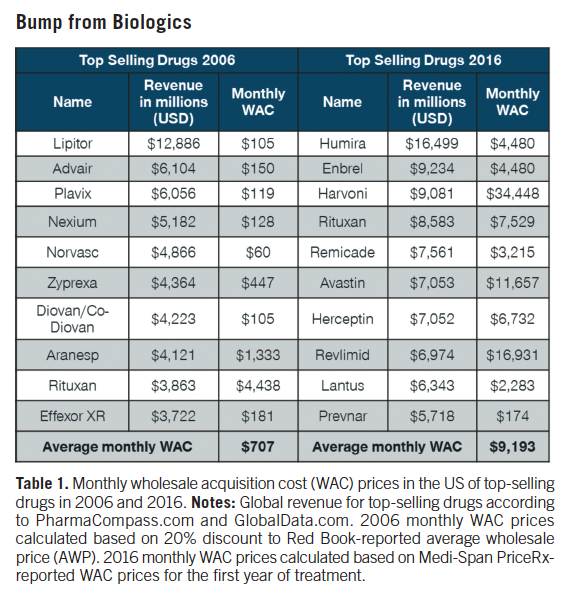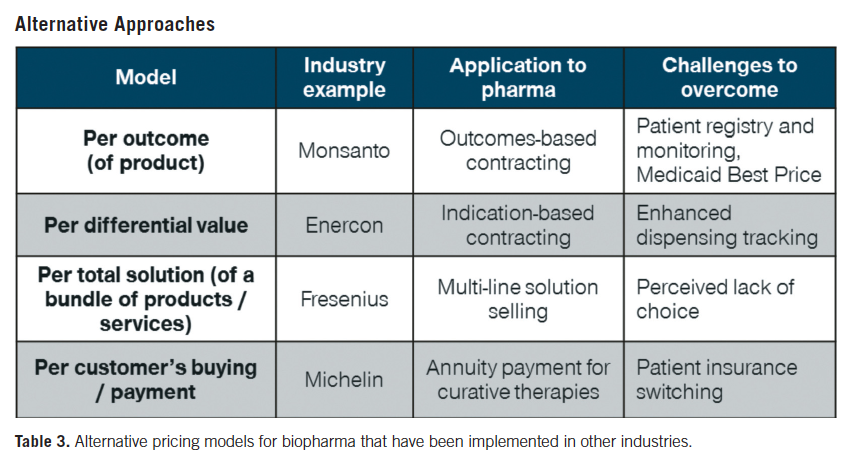Pricing Turning Point: The Case for Innovating Pharma’s Model
Pharmaceutical Executive
Drawing from implementation lessons and successes in other industries, possible strategy shifts to pharma’s pricing playbook are explored.
Outlining potential strategy shifts that could help evolve the industry’s pricing playbook-with a look at implementation lessons from other sectors and the unique hurdles to large-scale adoption in pharma
In antiquity, the Romans understood the affinity of price and value. In Latin, the word Pretium represented both price and value. In modern times, we speak about the concepts independently. In no other industry has the bifurcation of public perception of price and value been more acute than in the biopharmaceutical industry over the last decade. The perceived imbalance between price and value for drugs has led to negative publicity for the industry in the US, market access delays in Europe and other industrialized countries, and suboptimal penetration in many markets.
Despite the challenging environment, the biopharma industry is poised for tremendous innovation. It is said that as humans we over estimate what can be accomplished in the next 10 years and underestimate what can be accomplished in the next 50. Since Bayer gave birth to the industry back in 1899 with the launch of aspirin, tremendous value has been created for society at large. Lethal infections have been controlled, many killer diseases like heart disease and HIV are now managed, and debilitating conditions like rheumatoid arthritis (RA) have been moderated. Even in cancer, some forms like leukemia are already held at bay with targeted agents, and more forms of cancer will follow this path in the near future.
Progress in medicine is incremental in the short-term but life transforming in the long-term. The genomics revolution that started at the turn of the millennium is finally coming of age as new products developed based on this knowledge, including gene therapy, CRISPR, and CAR-T cell therapy, are making it to market. As the life sciences industry continues to charge ahead with product innovation, its ability to capture value requires it to also innovate in one area where it has largely remained stagnant: its price model.
Challenges under the current price model
A price model consists of two parts: How to charge (the basis)? And how much to charge (the level)? Pricing decisions in the industry have largely focused on the latter for the last 100 years. Since the turn of the millennium, there has been a drastic shift in the industry’s product portfolio as biologics (products derived from proteins) have established a presence by capturing market share from small molecules (products derived through chemical synthesis), raising attention on the price level.
When looking at the top selling drugs in 2006 vs. 2016, we can see a large increase in the number of biologics as well as specialty products. As a result of this shift, during this decade-long period, the monthly

price of the top 10 drugs in the US has grown by more than 10 times (see Table 1; click to enlarge). Back in 2006, the top-selling pharma product globally was Lipitor, priced at around $3.50 per day in the US, according to PharmaCompass.com and Red Book. The layperson could grasp the value Lipitor provided and could rationalize spending $3.50 per day on their health. Nowadays, top-selling biologics, though targeting much smaller populations, can cost more than $50,000 per year. If we consider orphan drugs (products for rare diseases), price levels can be over $500,000 per year, higher than the cost of the median home, the largest purchase for most people. The prices of these new-generation medicines look eye-popping under the current price model paradigm and are harder to communicate, not just in the US but also across global markets.
The model’s integral role in pharma’s future strategy
The pharma industry is not unique in reaching this turning point. Other industries have faced tremendous price pressure and competition and have effectively implemented shifts in their price models to strategically adjust. Even in heavily commoditized markets, a shift in price model can change the selling dynamics of an industry to align with the customers’ needs. The biopharma industry is no exception.
As such, we would like to highlight a few potential shifts that could help biopharma price models evolve concurrently with new product innovation to communicate value more intuitively.
Focus on output vs. input
The seed business in the agriculture industry is largely commoditized. Farmers have long made purchases on a per kilogram or per ton of seed basis, with the prices of those seeds fluctuating from year to year. One of the largest players in the industry is Monsanto. The company had historically been able to maintain its market position and technological edge in developing superior genetically modified seeds through patents and contracts with farmers. In order to fully capture the value of its genetically modified seeds, however, Monsanto went a step further and shifted to a royalty type price model, charging a fee after the crops were

harvested based on the yield.
This “end-use fee” shifted Monsanto’s price model from seed-based to yield-based pricing, i.e., from input- to outputbased.1 The change captures the production of each seed rather than simply the quantity of seeds, more closely aligning price and value. As farmers use more seeds and generate more yield, they pay Monsanto back a share of the excess profits, without impacting their upfront costs to purchase the seeds-a no-risk scenario for the farmers that captures upside for Monsanto.
In the same vein as seed pricing related to yield, a new price model that is recently gaining momentum in healthcare is the payment-by-results model (shift from price per month to price per outcome achieved). The price model shifts the focus of discussion away from purely cost to the goal that is being achieved, though it needs to evolve further as many times it becomes a discounting scheme vs. a truly payment-for-value scheme. Italy is farther along in accepting this type of price model (see related story in the March Pharm Exechere), but other countries have been opening up to it (see Table 2).

Capture differential value
In the industrial goods industry, Enercon is the third-largest manufacturer of wind turbines in the world. Industrial goods companies like Enercon make the majority of their revenue from the maintenance of their products, generally entering into monthly or annual maintenance contracts. When Enercon introduced a new wind turbine that was gearless and required less maintenance because it broke down much less frequently than competitors, it used the opportunity to introduce a new price model. Enercon has been able to maintain its market position despite charging a premium for this new turbine, however, as a result of the differential value offered by its pricing model.
Under Enercon’s Partner Concept, customers sign up for maintenance, services, and repairs at a price dependent on the yield of their turbine. Because Enercon’s turbines do not contain gears, they can guarantee more uptime versus competitors.2 More wind results in a higher yield, which brings more value to the customer, at which point Enercon can charge a higher price. Not only does this capitalize on the efficiency of all turbines, but it also generates differential value depending on the location of the turbines due to its yield-based pricing. If certain turbines are exposed to more wind, they too will generate higher yield and more value to the customer, further supporting Enercon’s ability to charge a higher price.
This new price model has resulted in 90% of Enercon customers entering into 12-year service contracts and Enercon’s ability to capture differential value based on the design and location of their wind turbines.
In the Enercon example, the same turbine in a different location could yield a different value. In oncology, indication expansion acts in a similar way. Each new indication may have varying safety and efficacy profiles vis-à-vis different competitors and in absolute terms, e.g., higher overall survival (OS) or progression free survival (PFS) as compared to prior indications, introducing different price potential. Some manufacturers have provided indication-based pricing solutions in order to achieve the optimal pricing for each indication, e.g., Genentech’s Avastin. In Italy, for example, separate risk-sharing agreements apply on an indication-by-indication basis for Avastin, and a specific additional 7% discount applies to the product when used in advanced colorectal cancer.3
This indication-based pricing concept poses an opportunity for manufacturers to capture differential value as their products’ labels continue to expand and payers discern whether they believe more nuanced coverage is warranted for treatments by indication.
Offer total solution vs. components
Medical technology products have often been sold à la carte. The capital equipment component is used in a hospital or outpatient setting and the technology component may include additional services. The manufacturer largely makes a return on the initial purchase and the maintenance of the equipment.
Fresenius Medical Care historically operated like any other medical technology manufacturer. In the 1960s and ’70s, Fresenius sold dialysis machines and dialyzers built by other companies until producing its A2008 dialysis machine in a newly acquired factory in 1979. From 1979 until the early 21st century, Fresenius continued to advance its dialysis offerings, with the merger of Fresenius Worldwide Dialysis and National Medicare, resulting in the listing of Fresenius Medical Care at the stock exchanges in Frankfurt and New York. Despite various advances, it wasn’t until 2006 that the current Fresenius Medical Care model was created with the acquisition of Renal Care Group. This acquisition introduced a network of 2,000 dialysis clinics around the world through which Fresenius could provide dialysis treatments. Not only did Fresenius continue to produce dialysis machines and dialyzers, but it incorporated settings of care to sell and utilize

that equipment. The company shifted from individual product selling to solution selling, opening the door to providing patients with a one-stop shop.
In integrating forward from a supplier to a full-service provider, Fresenius Medical Care is now the world’s leading provider of products and services for people with chronic kidney failure.
In several indications, manufacturers have begun to understand the advantage of being able to provide a suite of solutions. In oncology, for example, patients may advance beyond a certain therapy, requiring physicians to prescribe multiple lines or a stack of treatments. Manufacturers have begun to assemble product portfolios that span across the stages of disease progression.
With this portfolio of products, a manufacturer could provide a predictable cost for the payer in exchange for customer retention over time if the patient remains within their product family for treatment. For instance, in multiple sclerosis (MS), RA, hemophilia, or oncology, manufacturers could offer a price per month regardless of which product or how many are needed, as long as they are from the same manufacturer and the patient initiates the necessary treatment without any delays. As a full-service provider of therapies, a manufacturer could consider treatment on a per-patient basis rather than per drug and payers could more easily forecast and track the costs associated with each patient.
Align payments with customer buying cycle
Tire selling, like drugs, was historically based on a simple price model-price per tire. With the entry of competition from developing countries, particularly from the Far East, tire manufacturers started to feel the pinch. When Michelin developed a new tire that lasted 25% longer than existing tires, the company found it difficult for customers to accept a premium.2 Rather than giving away the innovation, Michelin changed its price model. Truck fleets, a key customer segment, track cost per mile for each truck as their revenue model is also based on charging its customers per mile.
Michelin decided to adapt its price model and to offer the new tires on a price per mile rather than per-tire basis.2 The company then offered a contract to replace the tires after they wore down. Under this new price model, customers perceived a parity price as they were not asked to pay more, while the longer-lasting tire from Michelin was able to capture a premium for its innovation.
Payers currently operate on annual budget cycles. This poses a particular challenge for upcoming therapies that require a one-time treatment but have a benefit that lasts for many years (e.g., gene therapy, CRISPR). Based on the current price model, a patient would pay for their CRISPR therapy at the time of treatment. Unlike other courses of treatment, however, there would not be any refills or additional treatments because it is curative. The manufacturer would, therefore, need to capture the value of that curative treatment upfront, a price that-depending on the indication and level of medical need-could be staggering.
An annuity price model could address this concern. Much like a mortgage on a house, under the annuity model, payers would pay for the product over time vs. having an upfront payment. The annuity could simply spread the payment over a number of years (e.g., 10 or 15), or could be a lifetime model. If the patient were to pass away shortly after taking the medication in the lifetime model, the total revenue on the medication is low. If, however, the patient lives longer due to the efficacy of the treatment, the payment is high. The risk is, therefore, fully aligned with the status of the patient. Departing slightly from the mortgage example, the payment for a one-time treatment could also be variable and tied to specific other outcomes.
Paving the way for new price models
Though not exhaustive, the four price model shifts we highlighted could help the biopharma industry adapt to ever innovative product offerings (see Table 3 below). In order to support these shifts in larger scale, some hurdles would need to be overcome. In particular, patient and dispensation monitoring; mitigating concerns of portfolio offerings; Medicaid “Best Price” implications in the US; and collaboration across insurers in fragmented markets like the US would need to be addressed.

Patient registry and monitoring
Indication-based pricing and performance-based price models would require enhanced monitoring. Privacy laws and the interconnectivity of devices have laid the groundwork for monitoring enhancements. In many cases, pharmacies and practices would need to further augment their dispensation tracking in order to differentiate not only between the drugs they prescribe but also for which indications they are being prescribed. Performance-based price models would also require patient registries in order to more centrally track specific outcomes. Policymakers and insurers could streamline the implementation of such tracking enhancements with alignment on common or compatible tracking standards.
Medicaid Best Price
The Medicaid Best Price policy requires drug manufacturers to offer state Medicaid programs the lowest of 23.1% off the list price or the best price offered to any other private or public purchaser if such a purchaser receives more than the minimum discount.4 Under this law, offering performance-based agreements or indication-based pricing could trigger additional rebates to Medicaid resulting from the method used to calculate best price. Policymakers would need to amend the Medicaid Best Price policy to revise the method of calculating best price.
Portfolio-based contracting perception
In some cases, physicians and insurers are hesitant to enter into portfolio-based contracts because they are concerned with losing autonomy/choice. Manufacturers could alter this perception with an emphasis on patient-support programs and other added benefits patients and insurers could gain from receiving multiple therapies for a patient from the same manufacturer.
Inter-insurance agreements
In healthcare systems such as the US, with fragmented payers, where patients tend to switch insurers regularly, spreading out treatment cost across several years to match the annual budget cycle of payers can be challenging. In order to alleviate this, there would need to be an inter-insurer agreement to deal with the outstanding payments. Similar agreements already exist in other industries, such as the inter-bank credit agreements established for syndicating loans.
Education and alignment
While new price models can facilitate the communication of value, no price model will be successful in a world where the industry has a bull’s-eye on its back as a key target for cost containment. As an industry, the biopharma sector needs to help educate not just physicians, but also policymakers and the public on the

benefits brought by innovation to society at large. As societies get wealthier, they are likely to spend a larger proportion of income on healthcare. The discussion around drug spending should, therefore, revolve more around the concept of effective spending versus the percentage of the budget it represents. In a recent industry study conducted by Simon-Kucher and Partners, the number one limitation for future revenue growth according to industry executives and managers was price.
The price models we highlighted are newer to the biopharma industry but time-tested in other sectors. With buy-in from policymakers and the correct enhancements to pave the way for implementation, these new price models could help right the biopharma sector’s price perception and better align with the value created to help unleash the newest wave of innovation.
Juan F. Rivera is the US Managing Partner and Caitlyn Macdonald is a Consultant, both in the Boston office of Simon-Kucher & Partners, Strategy & Marketing Consultants
References
1. Jeske, Diane et.al. “A Case Study: The Monsanto Decision.” University of Iowa. https://www.uvu.edu/ethics/seac/Jeske%20response.pdf
2. Simon, Hermann. Confessions of the Pricing Man: How Price Affects Everything. New York. Springer International. 2013.
3. Pearson, Steven D, et al. “Indication-Specific Pricing of Pharmaceuticals in the United States Health Care System.” ICER-Review, Institute for Clinical and Economic Review. March 2016, icer-review.org/wp-content/uploads/2015/03/Final-Report-2015-ICER-Policy-Summit-on-Indication-specific-Pricing-March-2016_revised-icons-002.pdf
4. “Health Policy Brief: Medicaid Best Price.” Health Affairs, August 10, 2017. DOI: 10.1377/hpb2017.8

Cell and Gene Therapy Check-in 2024
January 18th 2024Fran Gregory, VP of Emerging Therapies, Cardinal Health discusses her career, how both CAR-T therapies and personalization have been gaining momentum and what kind of progress we expect to see from them, some of the biggest hurdles facing their section of the industry, the importance of patient advocacy and so much more.